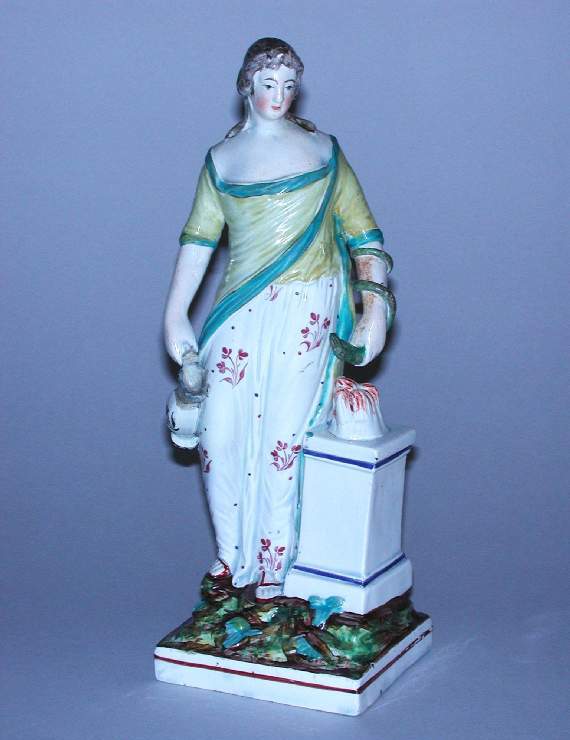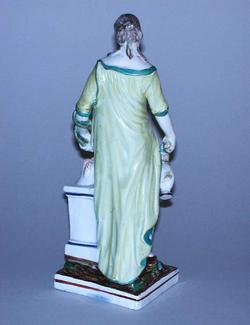Current Location: In storage
Titles
Hygieia
Maker(s)
Production:
Unidentified Staffordshire factory
Entities
Categories
Description
Lead-glazed earthenware figure of Hygieia painted in polychrome enamels
White earthenware, press-moulded, with blue-tinted lead-glaze, painted in blue, turquoise, two shades of green, yellow, flesh-pink, puce, red, reddish-brown, and brown enamels. The figure is supported on a mound on a square straight-sided base, which is open and glazed inside, and has a reddish-brown line running round the outside. The goddess Hygieia stands on the mound beside a rectangular altar with flames rising from its top. She is turning slightly to her left, and holds a ewer in her right hand and on her left arm has a green coiled snake which she holds over the altar. She has pink cheeks, and brown hair which is swept back into a bun at the back with three tresses falling down over her shoulders. She wears a low-necked yellow dress with turquoise edgings which is long at the back, and drawn sideways at the front to show a long white skirt decorated with puce floral sprays and blue dots. Her feet are clad in sandals with reddish-brown straps. The mound is coloured green and brown with four turquoise leaves at the front, and the altar has horizontal blue bands below the top moulding and above the bottom moulding.
Notes
History note: Bought in Cannon Street, City in 1892 with another figure for £1.15s.0d. by Dr J.W.L. Glaisher, FRS, Trinity College, Cambridge
Legal notes
Dr J. W. L. Glaisher Bequest
Measurements and weight
Height: 23.5 cm
Width: 9.2 cm
Acquisition and important dates
Method of acquisition: Bequeathed
(1928-12-07)
by
Glaisher, J. W. L., Dr
Dating
18th Century, Late-19th Century, Early
George III
Circa
1790
-
1810
Note
Hygieia was the ancient Greek goddess of health, and was the daughter of Asclepius, the god of medicine. In classical sculpture she was often shown holding or feeding a snake.
School or Style
Neoclassical
People, subjects and objects depicted
Components of the work
Decoration
composed of
enamel
( blue, turquoise, two shades of green, yellow, flesh pink, puce, red, reddish-brown, and brown)
Surface
composed of
lead-glaze
( slightly tinted blue)
Base
Depth 7.2 cm
Width 8.4 cm
Surface Overall
Materials used in production
white
Earthenware
Techniques used in production
Press-moulding
: White earthenware, press-moulded, covered with slightly blue-tinted lead-glaze, and painted in blue, turquoise, two shades of green, yellow, flesh pink, puce, red, reddish-brown, and brown enamels
Inscription or legends present
- Text: D
- Location: Inside back wall of based
- Method of creation: Impressed
- Type: Letter
References and bibliographic entries
Identification numbers
Accession number: C.895-1928
Primary reference Number: 76304
Old object number: 299
Stable URI
Audit data
Created: Saturday 6 August 2011
Updated: Tuesday 30 April 2024
Last processed: Tuesday 15 July 2025
Associated departments & institutions
Owner or interested party:
The Fitzwilliam Museum
Associated department:
Applied Arts





